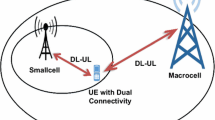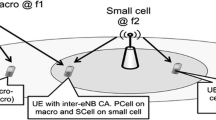Abstract
Dual-Connectivity architecture allows each user’s equipment (UE) to simultaneously communicate with two kinds of serving base stations (BSs) via two different radio-interfaces. Dual-Connectivity paradigm emerges as a promising solution to boost system capacity in fifth-generation heterogeneous network (HetNet), deploying multiple kinds of BSs, such as Femto BSs (FBSs), Pico BSs (PBSs) and Macro BSs (MBSs). In this paper, a comprehensive study of Dual-Connectivity in the downlink HetNet is analyzed via the framework of stochastic geometry, where the deployments of the BSs are modeled as mutually independent homogeneous Poisson point processes. In the conventional Dual-Connectivity, only the combination of MBS and SBS is available to access. In this paper, we consider that each UE can be simultaneously associated with any two types of BSs. The analysis is divided into two parts. We first derive the association probabilities of different combinations for Dual-Connectivity and then evaluate the average downlink throughput with the help of the association probabilities and the distance distributions to the serving BS. Moreover, we analyze the impact of the relative density of FBSs (or PBSs) on the association probabilities of different cases. Also, we compare the average downlink throughput of our considered Dual-Connectivity with those of conventional Dual-Connectivity and single association. Numerical results prove the validity of the theoretical analyses and demonstrate that our considered Dual-Connectivity owns superior performance on the throughput in HetNet, especially in the dense deployed SBS HetNet.




Similar content being viewed by others
References
Damnjanovic, A., Montojo, J., Wei, Y., Ji, T., Luo, T., Vajapeyam, M., et al. (2011). A survey on 3GPP heterogeneous networks. IEEE Wireless Communications, 18(3), 10–21. https://doi.org/10.1109/MWC.2011.5876496.
Lema, M. A., Pardo, E., Galinina, O., Andreev, S., & Dohler, M. (2016). Flexible dual-connectivity spectrum aggregation for decoupled uplink and downlink access in 5G heterogeneous systems. IEEE Journal on Selected Areas in Communications, 34(11), 2851–2865. https://doi.org/10.1109/JSAC.2016.2615185.
3GPP. (2014). Study on small cell enhancements for E-UTRA and E-UTRAN; higher layer aspects. Retrieved from http://www.3gpp.org/dynareport/36842.htm.
Luan, Z., Qu, H., Zhao, J., & Chen, B. (2016). Low complexity distributed max-throughput algorithm for user association in heterogeneous network. Wireless Personal Communications, 87(4), 1147–1156. https://doi.org/10.1007/s11277-015-3045-3.
Zhouyun, W., Weiliang, X., Fengyi, Y., & Qi, B. (2016). User association in heterogeneous network with dual connectivity and constrained backhaul. China Communications, 13(2), 11–20. https://doi.org/10.1109/CC.2016.7405721.
Prasad, A., & Maeder, A. (2015). Backhaul-aware energy efficient heterogeneous networks with dual connectivity. Telecommunication Systems, 59(1), 25–41. https://doi.org/10.1007/s11235-014-9893-4.
Wu, Y., He, Y., Qian, L., Huang, J., Xuemin, & Shen. (2015). Joint scheduling and power allocations for traffic offloading via dual-connectivity. In Proceedings of IEEE international conference on communications (IEEE ICC’16), (2), pp. 1–6. Retrieved from http://arxiv.org/abs/1509.09241.
Ahmad, S. A., & Datla, D. (2015). Distributed power allocations in heterogeneous networks with dual connectivity using backhaul state information. arXiv:1501.06851 [cs, math], 14(8), 4574–4581. https://doi.org/10.1109/twc.2015.2422818.
Shi, Y., Qu, H., & Zhao, J. (2017). Dual connectivity enabled user association approach for max-throughput in the downlink heterogeneous network. Wireless Personal Communications, 96(1), 529–542.
Chiu, S. N., Stoyan, D., Kendall, W. S., & Mecke, J. (2013). Stochastic geometry and its applications. New York: Wiley.
Jo, H.-S., Sang, Y. J., Xia, P., & Andrews, J. G. (2011). Heterogeneous cellular networks with flexible cell association: A comprehensive downlink SINR. Analysis, 11(10), 3484–3495. https://doi.org/10.1109/TWC.2012.081612.111361.
Smiljkovikj, K., Popovski, P., & Gavrilovska, L. (2015). Analysis of the decoupled access for downlink and uplink in wireless heterogeneous networks. IEEE Wireless Communications Letters, 4(2), 173–176. https://doi.org/10.1109/LWC.2015.2388676.
Smiljkovikj, K., Elshaer, H., Popovski, P., Boccardi, F., Dohler, M., Gavrilovska, L., et al. (2014). Capacity analysis of decoupled downlink and uplink access in 5G heterogeneous systems. arXiv preprint arXiv:1410.7270, pp. 1–26. https://doi.org/10.1109/iccw.2015.7247166.
Acknowledgements
This work is supported by the National Natural Science Foundation of China (No. 61531013), the National Science and Technology Major Project of China (No. 2018ZX03001016) and the Research Fund of Ministry of Education-China Mobile under Grant No. MCM20150102.
Author information
Authors and Affiliations
Corresponding author
Additional information
Publisher's Note
Springer Nature remains neutral with regard to jurisdictional claims in published maps and institutional affiliations.
Rights and permissions
About this article
Cite this article
Shi, Y., Qu, H., Zhao, J. et al. Analysis of Dual Connectivity for Downlink Access in 5G Heterogeneous Network. Wireless Pers Commun 102, 309–323 (2018). https://doi.org/10.1007/s11277-018-5841-z
Published:
Issue Date:
DOI: https://doi.org/10.1007/s11277-018-5841-z




